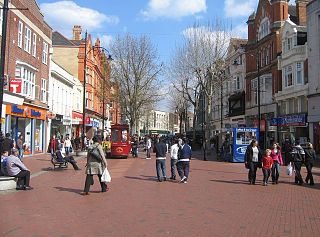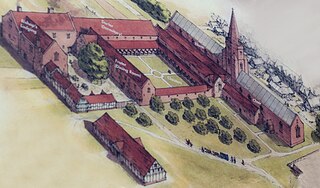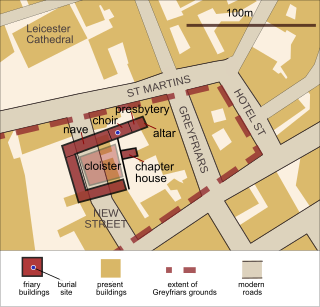
Reading Abbey is a large, ruined abbey in the centre of the town of Reading, in the English county of Berkshire. It was founded by Henry I in 1121 "for the salvation of my soul, and the souls of King William, my father, and of King William, my brother, and Queen Maud, my wife, and all my ancestors and successors." In its heyday the abbey was one of Europe's largest royal monasteries. The traditions of the Abbey are continued today by the neighbouring St James's Church, which is partly built using stones of the Abbey ruins.

Reading School is a state grammar school for boys with academy status in the English town of Reading, the county of Berkshire. It traces its history back to the school of Reading Abbey and is, thus, one of the oldest schools in England, although it closed for a few years in the 1860s. It is a state boarding school. There are no tuition fees for day pupils, and boarders only pay for food and lodging. Reading is one of the best state schools in the UK according to the GCSE and A-level tables and has consistently ranked in the top ten.

Reading Civic Centre was a civic centre in the town of Reading, itself in the English county of Berkshire. The centre dated from the mid-1970s.

Broad Street is a main pedestrianised thoroughfare and the primary high street in the English town of Reading. The street is situated in the town centre, running for approximately 0.25 miles (0.40 km), from west to east. The western end of the road lies at the crossroads with Oxford Road, West Street and St Mary's Butts. The eastern end continues as King Street after the junction with Minster Street and Butter Market.

Greyfriars, Dunwich was a Franciscan friary in Dunwich in the English county of Suffolk. The friary was founded before 1277 by Richard FitzJohn and his wife Alice and dissolved in 1538. The original site, which had 20 friars in 1277 when it first appears in records, was threatened by coastal erosion and the friary was moved inland in 1289.

Watlington House is a 17th-century building, with a large walled garden, in the town of Reading in the English county of Berkshire. The building is brick built and is reputed to be the oldest surviving secular building in the town. It is a listed building, being listed grade II*. The information on the Historic England website is https://historicengland.org.uk/listing/the-list/list-entry/1321898

Reading Town Hall is the town hall of Reading, Berkshire, England. The town hall was built in several phases between 1786 and 1897, although the principal facade was designed by Alfred Waterhouse in 1875. Situated close to the site of Reading Abbey, it is adjoined to the north by the Hospitium of St John and to the south by St Laurence's Church.

The Franciscan Friary was once a large estate located on the west side of Lichfield city centre in Staffordshire. The estate was built and inhabited by the Franciscan Friars from 1237. At one time the estate consisted of a large church, a cloister, dormitory lodge and a refectory building as well as many other domestic dwellings.

Friar Street is a thoroughfare in the English town of Reading. It runs parallel to Broad Street, connected by Union Street, Queen Victoria Street and Cross Street. At the western end is the Greyfriars Church and at the eastern end are the Town Hall and St Laurence's Church.

Queen Victoria Street is a pedestrianised thoroughfare in the English town of Reading, Berkshire. It connects Broad Street with Friar Street and Station Road.

St Mary's Butts is a thoroughfare in the English town of Reading, Berkshire. On its west side is the Broad Street Mall. It is connected to the north with Broad Street, the pedestrianised primary high street of Reading. St Mary's Church and Butts are where the town of Reading originally grew from.

The George Hotel is a hotel and former coaching inn in the town of Reading in the English county of Berkshire. It is situated in the eastern end of the town centre, on the corner of King Street and Minster Street, next to The Oracle shopping mall. It is a Grade II listed building.

High Bridge, sometimes known as Duke Street Bridge, is a bridge across the River Kennet in the town centre of Reading in the English county of Berkshire. It links Duke Street, to its north, and London Street, to its south. High Bridge is the oldest surviving bridge across the Kennet, and is a grade II listed building. It comprises a single arch of vermiculated Portland stone, with a plain keystone of ashlar.
Occupation at the site of Reading may date back to the Roman period, possibly as either a trading port on the River Thames, or as an intersection on the Roman road connecting London with Calleva Atrebatum near Silchester.
Adam de Lathbury, O.S.B., otherwise known as Adam of Lathbury or Adam Lothbury, was a Benedictine monk who ruled as Abbot of Reading Abbey, in the English county of Berkshire, from 1226 to 1238.

Greyfriars, Leicester, was a friary of the Order of Friars Minor, commonly known as the Franciscans, established on the west side of Leicester by 1250, and dissolved in 1538. Following dissolution the friary was demolished and the site levelled, subdivided, and developed over the following centuries. The locality has retained the name Greyfriars particularly in the streets named "Grey Friars", and the older "Friar Lane".

Lislaughtin Abbey is a medieval Franciscan friary and National Monument located in County Kerry, Ireland.

Ardfert Abbey, also known as Ardfert Friary, is a ruined medieval Franciscan friary and National Monument in Ardfert, County Kerry, Ireland. It is thought to be built on the site of an early Christian monastic site founded by Brendan the Navigator. The present remains date from the mid-thirteenth century, with the residential tower being added in the 15th century. The friary was dissolved in 1584.

The Hospitium of St John the Baptist was the hospitium, or dormitory for pilgrims, of Reading Abbey, which today is a large, ruined abbey in the centre of the town of Reading, in the English county of Berkshire. The hospitium was founded in 1189, and at its maximum comprised a range of buildings that could accommodate 400 people. The main building has survived, and is grade II listed. Much of the remainder of the original hospitium was located where Reading Town Hall now stands.























